Autism exercise programs are structured activities designed to enhance physical health‚ emotional well-being‚ and social skills in individuals with autism. These programs often include tailored routines like aquatic therapy‚ horseback riding‚ and sensory-friendly exercises‚ providing a supportive environment for growth and development. By focusing on individual needs and abilities‚ these programs foster adaptability and inclusivity‚ helping participants thrive physically and emotionally.
Importance of Physical Activity for Individuals with Autism
Physical activity is vital for individuals with autism‚ improving sensory integration‚ motor skills‚ and emotional well-being. It reduces sensory sensitivities‚ enhances focus‚ and boosts self-esteem. Regular exercise fosters better social interactions and communication. Structured programs like horseback riding and swimming provide a calming‚ predictable environment‚ helping individuals manage anxiety and stress. Consistency in routines is key‚ ensuring sustained growth and adaptation. These benefits highlight the transformative impact of tailored exercise programs on both physical and emotional development for autistic individuals‚ making physical activity an essential component of their care and support.
Overview of Autism Exercise Programs
Autism exercise programs offer a variety of structured activities tailored to meet the unique needs of individuals with autism. These programs often include therapies like horseback riding‚ swimming‚ and trampoline exercises‚ designed to improve physical skills and emotional well-being. Many programs incorporate sensory-friendly environments and visual supports to ensure comfort and engagement. Developed by professionals‚ these routines aim to enhance motor skills‚ reduce sensory challenges‚ and promote overall development. By providing predictable structures‚ autism exercise programs help individuals adapt and grow in a supportive setting.
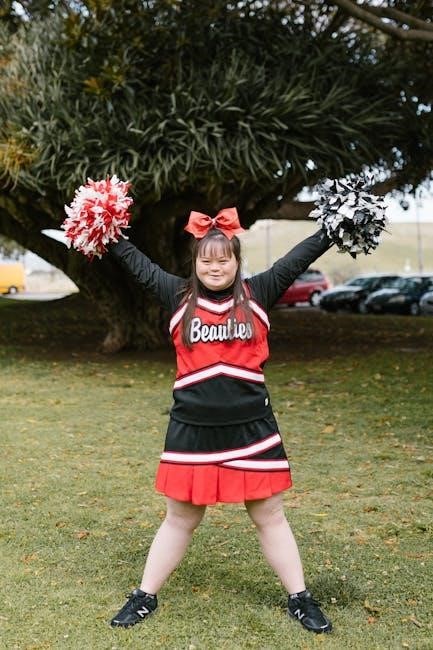
Benefits of Exercise for Autistic Individuals
Exercise offers numerous physical and emotional benefits for autistic individuals‚ enhancing motor skills‚ sensory integration‚ and social interaction while boosting self-esteem and overall well-being.
Improved Sensory Integration and Motor Skills
Exercise plays a critical role in enhancing sensory integration and motor skills for autistic individuals. Activities like horseback riding and swimming stimulate sensory processing‚ improving balance and coordination. Motor skills‚ such as running and jumping‚ are refined through structured routines. These exercises help individuals better navigate their environment and respond to sensory stimuli‚ fostering confidence and independence in daily activities while promoting overall physical and neurological development.
Enhanced Social Interaction and Communication
Exercise programs for autistic individuals often incorporate group activities that foster social interaction and communication. Team sports and shared physical routines encourage collaboration‚ helping participants develop teamwork and verbal/non-verbal communication skills. Structured exercises provide opportunities to practice social cues‚ share experiences‚ and build relationships with peers and instructors. These interactions‚ supported by clear instructions and visual aids‚ help individuals navigate social situations with greater confidence and ease‚ promoting meaningful connections and emotional growth.
Boosted Emotional Well-being and Self-esteem
Exercise programs for autistic individuals contribute significantly to emotional well-being and self-esteem. Physical activities like karate‚ swimming‚ and trampoline exercises help reduce stress and anxiety while fostering a sense of accomplishment. Achieving exercise-related goals builds confidence and self-worth‚ encouraging participants to embrace their abilities. These programs also provide a safe space for emotional expression and resilience building‚ helping individuals develop a positive self-image and improved mental health outcomes. Regular participation often leads to heightened happiness and a more balanced emotional state‚ enriching overall quality of life.

Effective Exercises for Autism
Autism exercise programs often include therapeutic horseback riding‚ aquatic therapy‚ trampoline exercises‚ and group sports‚ providing engaging physical activities tailored to individual needs and abilities.
Therapeutic Horseback Riding Programs
Therapeutic horseback riding is a widely recommended exercise for individuals with autism‚ promoting physical‚ emotional‚ and social growth. The rhythmic motion of horses helps improve motor skills‚ balance‚ and coordination. These programs are conducted by certified instructors who tailor activities to each participant’s needs‚ fostering trust and confidence. The calming environment of horseback riding also reduces anxiety and stress‚ while interactions with horses and instructors enhance social and communication skills. Many autism exercise programs highlight this activity for its holistic benefits and engaging nature.
Aquatic Therapy and Swimming
Aquatic therapy and swimming are highly effective for individuals with autism‚ offering a calming and structured environment. The buoyancy of water supports movement‚ improving flexibility and strength while reducing sensory overload. Swimming enhances motor skills‚ coordination‚ and cardiovascular fitness. Many programs incorporate water-based exercises to promote relaxation and focus. Trained instructors guide participants‚ ensuring safety and engagement. Aquatic therapy also fosters social interaction in group settings‚ building confidence and communication skills. Its versatility makes it a popular inclusion in autism exercise programs‚ tailored to diverse needs and abilities.
Trampoline and Bounce Exercises
Trampoline and bounce exercises are popular and effective for individuals with autism‚ offering a fun and engaging way to improve physical skills. These activities enhance balance‚ coordination‚ and rhythm while providing sensory integration benefits. The repetitive motion of bouncing can be calming and soothing‚ helping to regulate sensory processing. Many autism exercise programs incorporate trampolines due to their versatility and ability to cater to different energy levels and abilities. They also promote joy and self-expression‚ making them a valuable addition to structured exercise routines.
Group Sports and Team Activities
Group sports and team activities provide individuals with autism opportunities to develop social skills‚ teamwork‚ and communication. These structured environments encourage collaboration and mutual support‚ helping participants build friendships and confidence. Activities like soccer‚ basketball‚ or adaptive sports are often tailored to accommodate diverse abilities‚ ensuring inclusivity. Trained instructors and visual supports are frequently used to facilitate understanding and participation. Group sports also promote physical fitness while fostering a sense of belonging and shared accomplishment‚ making them a valuable component of autism exercise programs.
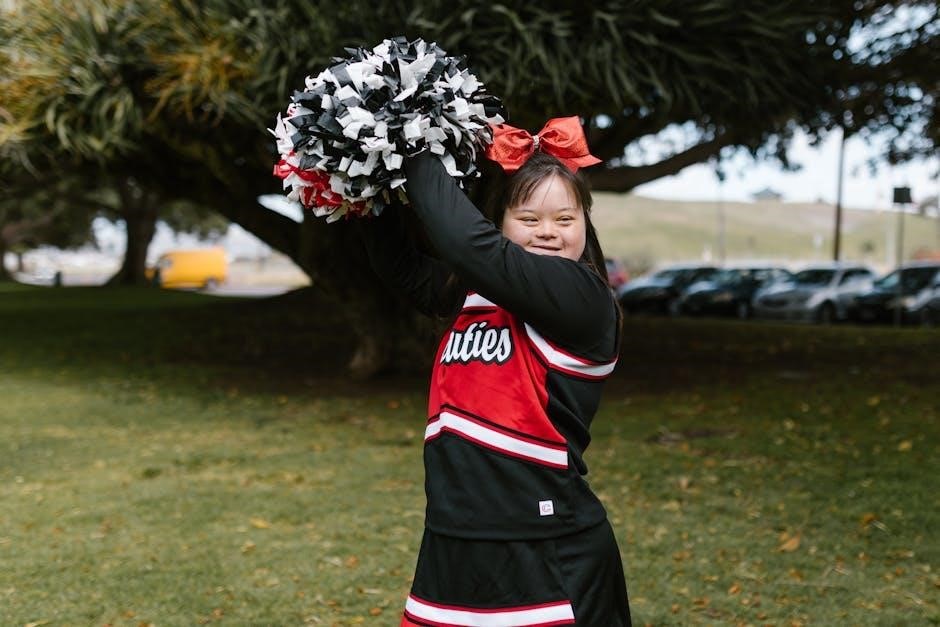
Creating a Structured Exercise Plan
A well-structured exercise plan for autism involves setting clear goals‚ using visual supports‚ and monitoring progress. Incorporate step-by-step routines and positive reinforcement to ensure consistency and engagement;
Setting Clear Goals and Objectives
Setting clear goals and objectives is crucial for effective autism exercise programs. These goals should be specific‚ measurable‚ and tailored to the individual’s needs and abilities. For instance‚ objectives might include improving motor skills‚ enhancing sensory integration‚ or boosting social interaction. Using tools like activity sheets and visual aids helps ensure understanding and participation. Regular assessments and adjustments keep the plan aligned with the individual’s progress‚ fostering a sense of accomplishment and motivation. Clear communication between caregivers and participants is key to achieving these goals effectively.
Monitoring Progress and Adjustments
Monitoring progress in autism exercise programs ensures activities remain effective and engaging. Regular assessments help track improvements in motor skills‚ sensory integration‚ and social interactions. Caregivers and therapists use tools like activity sheets and visual aids to document advancements and identify areas needing adjustment. Flexible plans allow for modifications based on individual responses‚ ensuring continued growth and motivation. Open communication between participants and supporters is vital for making informed adjustments and maintaining a positive‚ adaptive environment tailored to the individual’s evolving needs and preferences.
Incorporating Visual Supports and Schedules
Visual supports and schedules are essential for individuals with autism‚ providing clarity and structure. Tools like activity sheets‚ visual timers‚ and checklists help participants understand exercise routines and transitions. These supports reduce anxiety and enhance engagement‚ making exercises more enjoyable and effective. By incorporating visual aids‚ caregivers and therapists can create a predictable environment‚ fostering independence and confidence during physical activities. Consistent use of visual supports ensures a smooth and organized approach to exercise programs‚ tailored to individual needs and preferences.
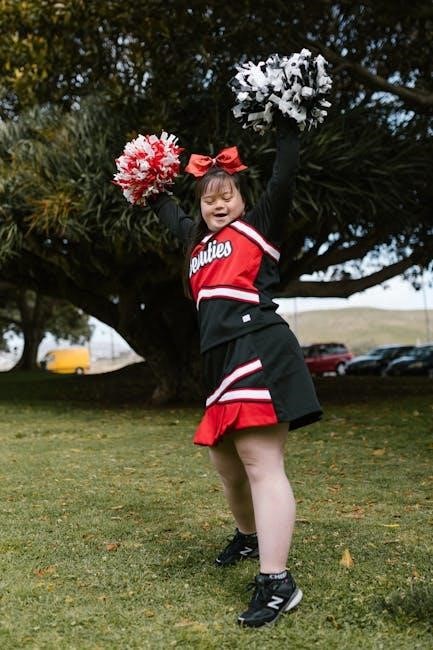
Safety and Supervision in Exercise Programs
Safety and supervision are crucial in autism exercise programs to prevent injuries and ensure a supportive environment. Trained instructors and caregivers play a key role in monitoring activities‚ adapting exercises to individual needs‚ and addressing sensory challenges. By maintaining a safe and structured setting‚ these programs help participants build confidence and skills while minimizing risks. Proper supervision ensures that exercises are executed safely‚ fostering an environment where individuals with autism can thrive and benefit fully from physical activities.
Role of Trained Instructors and Caregivers
Trained instructors and caregivers are essential in autism exercise programs‚ providing guidance‚ support‚ and adaptability. They ensure exercises are tailored to individual needs‚ helping participants navigate sensory challenges and behavioral difficulties. Their expertise fosters a safe‚ encouraging environment‚ allowing individuals with autism to engage confidently. Instructors also monitor progress‚ offering adjustments to maximize benefits. Caregivers assist with communication and emotional support‚ ensuring activities are enjoyable and effective. Their collaborative efforts are vital for the success and well-being of participants in these programs.
Ensuring a Safe and Supportive Environment
Creating a safe and supportive environment is crucial for autism exercise programs. This involves adapting spaces to meet sensory needs‚ using visual supports like schedules and signs‚ and ensuring equipment is accessible. Trained staff monitor activities to prevent accidents and provide immediate assistance. Flexibility in routines allows for individual adjustments‚ minimizing stress. Clear communication and positive reinforcement foster trust and confidence. Regular feedback from participants and caregivers helps maintain a secure and inclusive setting‚ ensuring everyone feels safe and supported throughout the program.
Handling Sensory Challenges During Exercise
Addressing sensory challenges is essential for autistic individuals during exercise. Strategies include using visual supports like schedules and cues to prepare for activities. Providing sensory-friendly environments‚ such as dim lighting or noise-canceling headphones‚ can reduce overwhelm. Instructors should monitor for sensory triggers and offer breaks in calming spaces. Adaptive equipment and tactile activities‚ like weighted vests or fidget tools‚ can also help regulate sensory experiences. Collaboration between caregivers and instructors ensures personalized approaches‚ fostering a comfortable and engaging exercise experience for all participants.
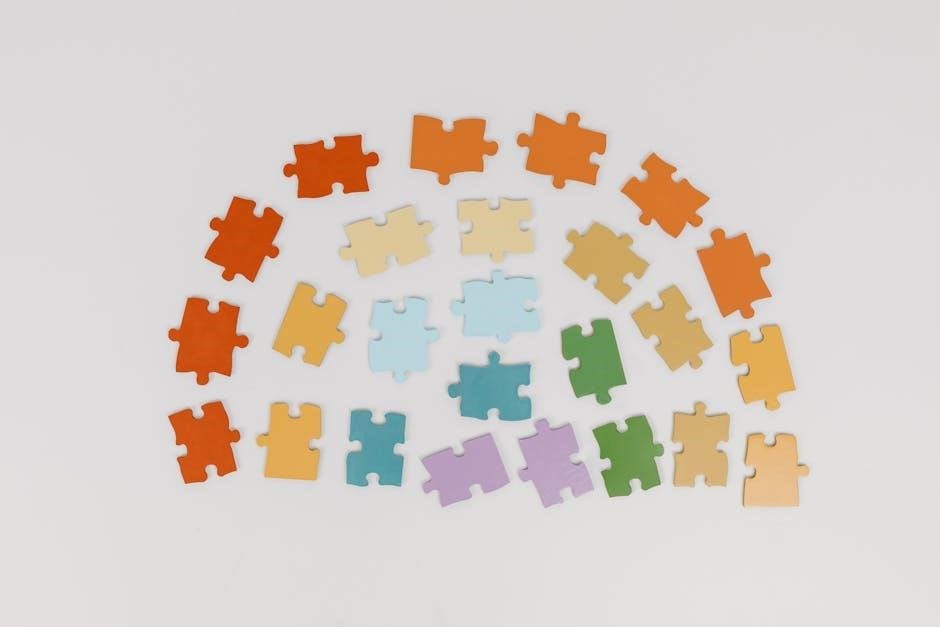
Technology and Autism Exercise Programs
Technology enhances autism exercise programs through apps offering guided routines‚ virtual reality for motor skill development‚ and online resources providing downloadable PDF guides for structured activities.
Using Apps for Exercise Routines
Apps designed for autism exercise routines provide interactive and structured programs tailored to individual needs. They often include visual supports‚ step-by-step instructions‚ and progress tracking features. Many apps offer customizable workout plans‚ reminders‚ and positive reinforcement to keep users motivated. Some apps also incorporate sensory-friendly activities and games to make exercise engaging. These tools empower individuals with autism to follow routines independently or with minimal supervision‚ fostering consistency and enjoyment in physical activity. They are a valuable resource for both home-based and therapeutic settings.
Virtual Reality in Motor Skill Development
Virtual reality (VR) is emerging as a powerful tool in motor skill development for individuals with autism. VR provides immersive‚ interactive environments that simulate real-life scenarios‚ helping users practice movements and coordination in a controlled setting. These programs often include games and activities that encourage repetition and precision‚ essential for improving motor skills. VR also offers the ability to tailor exercises to individual needs and abilities‚ making it a flexible and engaging option for therapy. Regular use can lead to significant improvements in coordination‚ balance‚ and overall motor function‚ boosting confidence and independence.
Online Resources and PDF Guides
Online resources and PDF guides offer comprehensive support for autism exercise programs‚ providing structured plans and activities tailored to individual needs. These guides often include sensory-friendly exercises‚ visual schedules‚ and strategies for parents and therapists. Many resources are downloadable‚ making them easily accessible for home or clinical use. They emphasize consistency‚ adaptability‚ and positive reinforcement‚ helping individuals with autism build physical skills and confidence. These materials are invaluable for creating inclusive and effective exercise routines that promote long-term growth and well-being.
Addressing Barriers to Exercise
Common barriers include sensory sensitivities‚ anxiety‚ and resistance to new activities. Strategies like gradual exposure‚ positive reinforcement‚ and sensory-friendly environments help overcome these challenges effectively.
Overcoming Sensory Sensitivities
Individuals with autism often face sensory sensitivities that can hinder participation in exercise. Strategies like using sensory-friendly equipment‚ gradual exposure to new environments‚ and incorporating visual supports can help. Caregivers and instructors should identify triggers and adapt activities to create a calming atmosphere. Techniques such as weighted blankets‚ noise-canceling headphones‚ or fidget tools may also be effective. Consistency and patience are key to helping individuals navigate sensory challenges and engage comfortably in physical activities‚ fostering a positive and inclusive experience.
Managing Anxiety and Resistance
Managing anxiety and resistance in autistic individuals during exercise requires a compassionate and structured approach. Identifying triggers and introducing activities gradually can reduce apprehension. Visual aids‚ such as schedules or choice boards‚ help provide clarity and control. Positive reinforcement‚ like praise or rewards‚ encourages participation. Collaborating with therapists to develop personalized strategies can also ease anxiety. Consistency in routines and allowing breaks when needed fosters a supportive environment‚ helping individuals feel more comfortable and engaged in physical activities over time.
Strategies for Inclusive Participation
Ensuring inclusive participation in autism exercise programs involves tailoring activities to individual needs and abilities. Using visual supports‚ such as schedules or choice boards‚ helps participants understand expectations. Adaptive equipment and modified exercises can accommodate sensory or motor challenges. Trained instructors and peer buddies create a supportive environment‚ fostering social interaction and confidence. Encouraging communication through gestures or assistive devices also promotes engagement. By addressing barriers proactively‚ these strategies ensure that everyone can participate meaningfully‚ benefiting both the individual and the group as a whole.
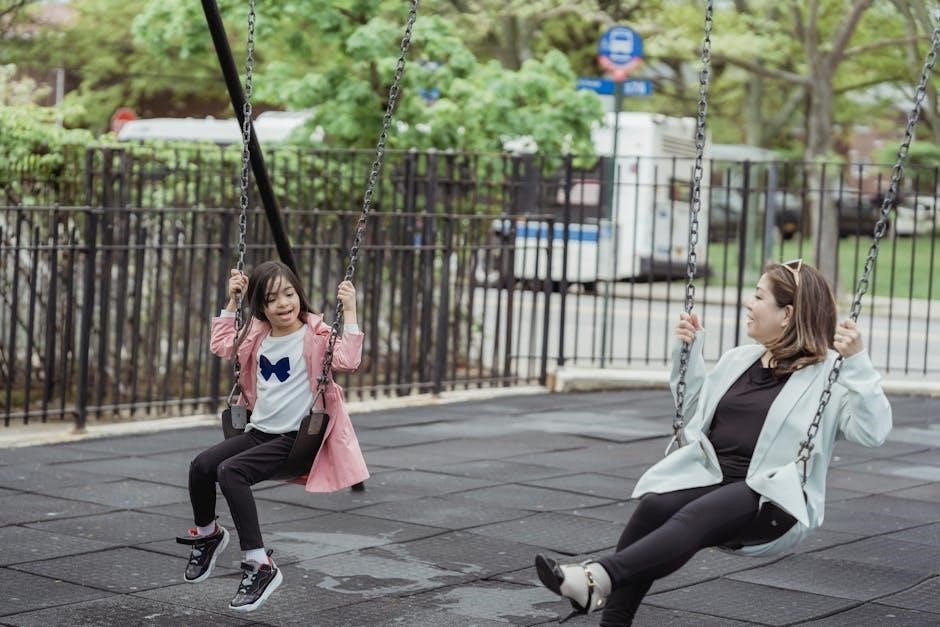
Parental Involvement in Exercise Programs
Parents play a vital role in encouraging physical activity for autistic children; Home-based exercises‚ visual supports‚ and collaboration with therapists foster consistency and adaptation to their needs.
Tips for Parents to Encourage Physical Activity
Parents can encourage physical activity by creating a safe and enjoyable environment. Using visual schedules and supports helps autistic children understand routines. Incorporating their interests‚ like swimming or trampoline exercises‚ makes activities engaging. Positive reinforcement‚ such as praise or rewards‚ motivates participation. Collaborating with therapists ensures activities are tailored to their needs. Consistency and patience are key‚ as small steps can lead to significant progress over time.
Home-based Exercise Routines
Home-based exercise routines provide a comfortable and familiar setting for autistic individuals to engage in physical activity. Parents can incorporate simple exercises like stretching‚ balancing‚ or dance sessions tailored to their child’s preferences. Visual supports‚ such as schedules or checklists‚ can help maintain consistency. Activities like trampoline exercises or yoga can be adapted to home environments‚ promoting sensory integration and motor skill development. These routines also offer opportunities for bonding and creating a supportive atmosphere‚ making physical activity a positive and enjoyable experience.
Collaboration with Therapists and Coaches
Collaboration with therapists and coaches is essential for designing effective exercise programs for autistic individuals. Trained professionals can tailor activities to meet specific needs‚ ensuring safety and engagement. They work closely with parents to create structured routines that promote skill development and sensory integration. By sharing expertise and adapting strategies‚ therapists and coaches help individuals thrive in physical activities‚ fostering confidence and independence. This teamwork ensures a supportive environment where goals are achieved and progress is celebrated.
Long-term Benefits and Commitment
Consistent participation in autism exercise programs fosters sustained physical and emotional growth‚ enhancing overall well-being. Long-term commitment ensures adaptability and progress‚ benefiting individuals and caregivers alike.
Sustained Physical and Emotional Growth
Regular participation in autism exercise programs promotes lasting improvements in motor skills‚ coordination‚ and sensory integration. Over time‚ individuals develop greater emotional resilience‚ self-esteem‚ and confidence. These activities also enhance focus and self-regulation‚ fostering a healthier lifestyle. Trained instructors and caregivers play a crucial role in tailoring exercises to individual needs‚ ensuring progress and adaptability. By maintaining consistency‚ participants experience measurable physical and emotional growth‚ leading to a more fulfilling and independent life. The benefits extend beyond the exercise itself‚ creating a foundation for lifelong well-being and personal development.
Importance of Consistency in Exercise Programs
Consistency is vital in autism exercise programs as it helps establish routines‚ reducing anxiety and building trust. Regular physical activity supports steady progress in motor skills‚ emotional regulation‚ and social interactions. A structured schedule ensures predictable environments‚ which are calming for individuals with autism. Over time‚ consistent participation fosters resilience‚ self-confidence‚ and a stronger connection to physical and emotional well-being. It also allows for better tracking of progress‚ enabling adjustments to meet evolving needs and goals‚ ensuring a meaningful and sustainable impact on overall development.
Community Support and Advocacy
Community support and advocacy play a crucial role in promoting autism exercise programs. Local organizations and support groups often provide resources‚ workshops‚ and events tailored to families and individuals with autism. Advocacy efforts help raise awareness about the benefits of physical activity for autistic individuals‚ fostering inclusive environments. Collaborative initiatives between parents‚ educators‚ and healthcare professionals ensure accessible and adaptive programs. Strong community backing not only enhances participation but also encourages societal acceptance‚ enabling individuals with autism to thrive and reach their full potential through consistent support and empowerment.
Autism exercise programs offer transformative benefits‚ enhancing physical‚ emotional‚ and social growth. Consistent participation fosters long-term well-being‚ empowering individuals with autism to lead fulfilling and active lives.
Final Thoughts on Autism Exercise Programs
Autism exercise programs are a powerful tool for enhancing the lives of individuals with autism‚ offering tailored activities that promote physical‚ emotional‚ and social growth. These programs provide structure‚ inclusivity‚ and a sense of community‚ which are essential for overall well-being. By emphasizing consistency and adaptability‚ they cater to diverse needs‚ ensuring each participant thrives. Caregivers and professionals play a vital role in supporting engagement and progress. With the right approach‚ autism exercise programs can foster a brighter‚ more active future for individuals on the autism spectrum.
Encouraging Implementation and Adaptation
Implementing autism exercise programs requires collaboration between caregivers‚ therapists‚ and participants. Tailoring activities to individual preferences and abilities ensures engagement and progress. Parents can encourage physical activity by incorporating fun‚ sensory-friendly exercises into daily routines. Utilizing visual supports and schedules helps create structure and predictability. Addressing sensory sensitivities and anxiety with gradual exposure and positive reinforcement fosters a positive experience. Community support and accessible resources further promote inclusivity‚ enabling individuals with autism to thrive in adaptive and meaningful ways.